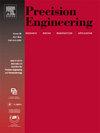“现在不要阻止我!”:三维x射线计算机断层扫描迭代重建的停止规则
IF 3.5
2区 工程技术
Q2 ENGINEERING, MANUFACTURING
Precision Engineering-Journal of the International Societies for Precision Engineering and Nanotechnology
Pub Date : 2025-02-03
DOI:10.1016/j.precisioneng.2025.01.019
引用次数: 0
摘要
x射线计算机断层扫描通常用于制造业,主要用于高价值小批量案例,因为数据采集时间较长。为了获得最佳结果,Nyquist准则建议为2000像素宽度的检测器获得3142个投影,原因是延长了检测时间。减少投影可以提高速度,但标准的FDK重建方法在图像质量和尺寸精度方面存在损失。迭代重建方法在数据有限,预测量少的情况下具有优势,是一种很有前途的重建方法。然而,它们在尺寸测量中的应用并没有最佳实践——尤其是在停止迭代的时候。在本研究中,使用SIRT迭代重建算法对100μm的多球面工件进行了重建,仅使用了17%(504个投影)的投影数据。将球体直径的双向测量与完整数据集的FDK重建进行了比较。在迭代重建中,每次迭代图像都会得到改进,直到达到一个半收敛点,在这个点上图像最能代表目标,之后来自投影的不必要的噪声开始被添加进来。在没有真象的情况下,通过测量的半收敛性来推导半收敛性。在这里,球体直径与FDK测量值的差异最多为0.0295体素(2.95μm),这与使用FDK重建完整数据集的重复采集的误差大小相同。图像度量被评价为一种较便宜的方法来识别测量的半收敛性。特别是各向异性质量指数(AQI)和清晰度被确定为候选规则,并强调了一些其他合理的停止规则,这些规则在这种情况下是不成功的。虽然它们不能识别精确的直径最小值,但它们都在半收敛点的0.008体素(0.8 μm)范围内。如果停止迭代的决定是合理的,迭代重建是一个很有前途的途径,可以通过相当精确和可重复的测量来减少检查时间。本文章由计算机程序翻译,如有差异,请以英文原文为准。
“Don’t stop me now!”: Stopping rules for iterative reconstruction with dimensional X-ray Computed Tomography
X-ray Computed Tomography is regularly exploited in manufacturing, primarily for high-value low-volume cases due to prolonged data acquisition times. For optimal results the Nyquist criterion suggests obtaining 3142 projections for a 2000 pixel width detector reasoning the extended inspection time. Reducing projections enhances speed but the standard FDK reconstruction method suffers a loss in image quality and dimensional accuracy. Iterative reconstruction methods excel with limited data such as fewer projections, offering a promising route forward. However, their application in dimensional measurement has no best practice — particularly when to stop iterating. In this study, a multi-sphere workpiece imaged at was reconstructed using SIRT, an iterative reconstruction algorithm, with just 17% (504 projections) of the projection data. The bi-directional measurements of sphere diameters were compared to the FDK reconstruction of the full dataset. In iterative reconstruction, the images improve with each iteration until a point of semi-convergence where it best represents the object, after which unwanted noise from the projections begins to be added. Without a ground truth image the semi-convergence is inferred by semi-convergence of measurement. Here, the difference in the sphere diameter against the FDK measurement is at most 0.0295 voxels () which is the same magnitude of error as repeated acquisitions with FDK reconstruction of a full dataset. Image metrics are evaluated as a less expensive way to identify the semi-convergence of measurement. In particular anisotropic quality index (AQI) and sharpness are identified candidate rules, as well as highlighting a number of other reasonable stopping rules which were unsuccessful in this scenario. While they cannot identify the precise diameter minima, they are all within 0.008 voxels (0.8 m) of the semi-convergence point. Iterative reconstruction is a promising route forward to decrease inspection times with comparably accurate and repeatable measurements if the decision of when to stop iterating is well justified.
求助全文
通过发布文献求助,成功后即可免费获取论文全文。
去求助
来源期刊
CiteScore
7.40
自引率
5.60%
发文量
177
审稿时长
46 days
期刊介绍:
Precision Engineering - Journal of the International Societies for Precision Engineering and Nanotechnology is devoted to the multidisciplinary study and practice of high accuracy engineering, metrology, and manufacturing. The journal takes an integrated approach to all subjects related to research, design, manufacture, performance validation, and application of high precision machines, instruments, and components, including fundamental and applied research and development in manufacturing processes, fabrication technology, and advanced measurement science. The scope includes precision-engineered systems and supporting metrology over the full range of length scales, from atom-based nanotechnology and advanced lithographic technology to large-scale systems, including optical and radio telescopes and macrometrology.

 求助内容:
求助内容: 应助结果提醒方式:
应助结果提醒方式:


